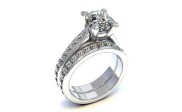Filters for Digital SLR Cameras
Camera Filters
Light is composed of different colors having each a different wavelength. Filters are put in front of a lens in order to let some of these wavelengths reach the sensor and to block other specific wavelengths and tones.
But, are photographic filters still relevant with the advances in digital photography? In some cases they will no longer be needed. For example, Skylight filters are no longer needed, as the photographer can now control white balance in camera. But, in other cases filters are still needed and are an important factor in the final result of an image. Filters which are still in use and are widespread among digital photographers are mainly protection filter, polarizing filters, and ND filters. Other types are also still in use like the infrared filter but they are designed for a specific type of photography and are not used very often.
UV Filters:

UV filter by JNuS
The use of UV filters allows the success in taking shots where the blue tone is dominant around the horizon (landscapes, sea, mountains…). The UV filter gives the photo a warmer tone by blocking these blue tones. But, with the advance of digital imagery, most of the lenses have now their own UV protection, making the use of a UV filter obsolete. However, it’s advisable to keep a UV filter on the lens most of the time for the sake of protecting it. If you bought a lens for thousands of dollars you would want to protect it from any eventual scratches, fingerprints, or crashes, and a UV filter plays the role perfectly. It’s better to lose a filter in case of an accident than to lose a lens.
Other filters are used also for protection, such as the skylight filter, but to a lesser degree than UV filters. It’s recommended, when buying a protection filter, to opt for the high end quality filters to make sure you get perfect shots. It’s no use putting a poor quality glass in front of your expensive lens, as it will only degrade the quality of your pictures.
Polarizing Filters:

Polarizing filters by sxc.hu
Polirizers have the function of eliminating non metallic reflections from a photo (reflactions on water or glass). And they also provide more saturated colors with more clarity and contrast in them. Circular polarizers (the most common for digital photography) are usually constituted of two elements. The first one is attached to the lens, and the second element has a ring which will allow you to move it in a circular movement to determine where you want the filter to have its effect in the frame. When taking a shot with a polarizing filter, move the ring while looking through the viewfinder and you will be able to see the changes in the photo you are taking. When you are satisfied with the effect of the filter and you got rid of the reflections in your shot, stop turning the filter’s ring and simply take your shot. Generally, no exposure compensation is needed, as most digital cameras have a through the lens metering system which will detect the presence of the filter and make the necessary adjustments.
Neutral Density Filters:

Neutral density filter by Emperley3
These filters, which look gray colored, are used for decreasing the intensity of the light reaching the camera sensor and thus, for enabling the photographer to use wider apertures and slower shutter speeds. They don’t affect white balance in any way. They act like a 1 stop decrease of the aperture value but without altering the depth of field. ND filters are usually used where there is too much light for wide apertures to be used. By placing them in front of your lens, you will be able to use a wide aperture to get a small depth of field without risking overexposure. They are also used when there is a need for slow shutter speeds in daylight. For example if you want to photograph the flow of a river or a waterfall you need to use an ND filter to get that smooth water effect. There are different types of ND filters each characterized by how much light they let into the lens. They are usually referred to by a number after the letters ND (ND1, ND2, ND3, ND4, etc). The bigger the number, the less light an ND filter will let into the camera.
There is also another type of neutral density filters which is gradual ND filters.

Camera filters by purplemattfish
These filters are the same as ND filters, but the only difference is that effect is gradual and will affect only a part of the photo. When you hold one of these filters you will be able to see that they go from a gray shade at the top to a transparent aspect at the bottom. They are very useful in photographing scenes which require a mixed exposure (which can be achieved through a HDR treatment in editing). For instance, if you are trying to capture a sunset scenery and you want the ground as well as the sky to be properly exposed and full of details. This is usually not possible with only your camera, as you will either get properly exposed sky and a silhouetted foreground or you will have a foreground where you can see all the detail and a sky that is blown out. Gradual ND filters are perfect for solving such problems. All you have to do is to place your filter in from of your lens with the gray part covering the sky and the transparent part covering the foreground. This will provide you with perfect exposures all over the frame, as the gray shaded part of the filter will decrease the amount of light reaching the camera from the sky and will make it equal to the light coming from the ground.
Filters in the digital age are mainly used to protect the lens, avoid reflections and overcome tricky situations which require different exposures. When buying a filter for your lens consider the quality of the filter, as it’s no use putting cheap glass in front of a high quality lens, and also keep in mind how often you will be using the filter. This will help you determine how much to spend on getting a filter.
What filters do you use for your DSLR?



